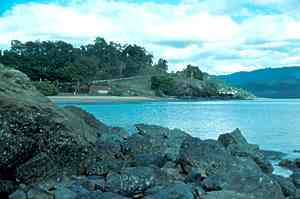|
|
Turbidity
Environmental Factors
Southern Australia:
Waters along southern shores in Australia are normally quite clear.
During periods of heavy rain and associated lowland flooding, mud may be carried down river and carried out through the river mouth to be deposited as a delta formation. In southern Australia, infrequently, either side of a river mouth is occasionally smeared with floodwater mud.
Near our cities, estuary, river and lake water pollution is becoming an increasing problem.
Question:
What can be done to decrease estuarine water pollution ?
Northern Australia:
In northern Australian embayments, especially where the large freshwater rivers enter the sea, turbid waters are thick with sediment during the annual monsoon season. Huge volumes of water carry huge volumes of phosphate-loaded mud, especially off agricultural land. This could be a major problem for the Great Barrier Reef.
 All
along the Queensland coast, north of Hervey Bay, the coastal shore often
resembles a muddy estuary. On many rocky shores there is a fine layer
of mud.
All
along the Queensland coast, north of Hervey Bay, the coastal shore often
resembles a muddy estuary. On many rocky shores there is a fine layer
of mud.
The rocky shores of Airlie Beach are coated with a fine layer of mud at low tide.
This suits creatures such as certain species of nerite mollusc, star limpets, cthahamlid barnacles, decapod crabs and holothurians, but excludes others. Some species of coral are suited to this muddy environment.
Instead of sand shores, many beaches in northern Australia are composed of sharp, angular, broken coral and shell debris. Algae is fairly rare in tropical Australia.
References
Bennett, I. (1987) W. J. Dakin's classic study: Australian Seashores. p. 3-12, Angus & Robertson, Sydney.
Davey, K. (1998) A Photographic Guide to Seashore Life of Australia. p.8, New Holland, Sydney.
Environmental
Factors
Latitude
Currents
Wind Effects
Wave Strength
Tidal Effects
Desiccation
Substrate
Turbidity
Salinity
Home
Page
Taxonomy
Biogeography
Rocky Shores
Tidal Levels
Intertidal Zonation
Environmental Factors
Biological
Factors
Feeding Relationships
Activities
Glossary
References
 Life
on Australian Seashores
Life
on Australian Seashores
by Keith Davey (C) 2000
Learning Consultant
- Media
The University of Newcastle
email at australian_seashores@hotmail.com
Scientific Consultant: Phil
Colman
site created 01.01.98 : updated 01.04.2000
